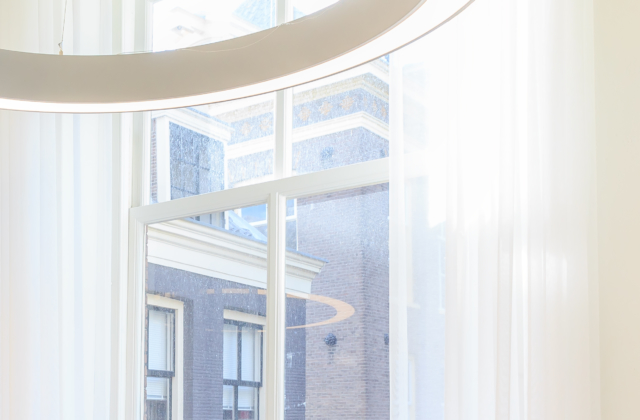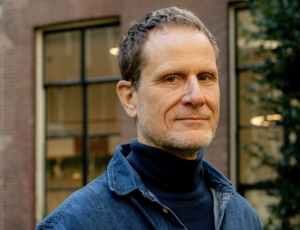
Fluorescent Tubes
My Fellowship at NIAS as Journalist-in-Residence
As I open the door to my office, the fluorescent tubes light up automatically. Along one wall stands a large desk with a computer. Against the other wall stands an empty bookcase. Downstairs, next to reception, is an In-Out attendance board with my name on it. I am expected to slide my nameplate from absent to present when I come in. For five whole months, I will occupy an office at the Netherlands Institute of Advanced Study (NIAS) and the first few days actually take a little getting used to. After leaving the Netherlands six years ago to work as a correspondent in Italy, Greece, and France, I mainly work at home at the kitchen table, in cafes, hotel rooms or even on the plane, between take-off and landing, balancing my laptop on that impractical foldout tray table. Sometimes I get up at six in the morning to finish a story. Sometimes I even fire up my laptop while on holiday. I rarely work from nine to five and nobody checks whether I am at work or not. But my NIAS office turns out to be the perfect work environment to write a book. I arrive early in the morning, close the door behind me and write all morning. Because of the fluorescent lights, I don’t even notice what kind of weather it is outside. In the afternoon, I read. Via the computer on my desk, I can request any reference book that I need. A few days later, the book is ready to collect from the library on the top floor. My bookcase quickly fills. Fellows’ footsteps along the corridor announce that it is half past twelve. My colleagues, researchers from the Netherlands, Libya, Romania, Ukraine, Canada, Germany, Mexico, Taiwan, Hong Kong, Ireland, Belgium and the United States of America, make their way to the lunchroom. The NIAS chef serves daily hot lunches and often asks what we would like to eat the next day. We sit at tables and chat about the news, medieval manuscripts, the lack of homes in Hong Kong, racism in Holland or Poland or the progress we are making on our research projects. When we first arrived, we gave a short presentation to explain to each other what we were going to work on over the coming months. Every Thursday morning in the conference room, one fellow has two hours to talk at more length about their own project and answer the fellows’ critical questions. The value of these seminars becomes especially clear to me when it is my turn. This is not the first time that I tell others about my book. People often ask me at parties. Usually, I can just about tell them it is a reconstruction of a trip by two Italian artists, wearing wedding dresses, who hitchhiked to Jerusalem. I tell people that it is a tragic tale: one of the artists was murdered along the way. Often I can add that I became interested when I discovered that the murdered artist’s sisters continued to hitchhike. They did not want their lives to be influenced by fear of something happening that, in their view, was highly unlikely. This started me thinking why certain risks make us so afraid. And if it could be worthwhile to take them anyway. Usually, these conversations last about ten minutes. Now I am able to talk for 45 minutes before the audience could react. I can introduce nuances and share details. I can describe what I have written so far and discuss my doubts and uncertainties. Should I highlight underlying themes in separate chapters or shall I deal with them implicitly as I go along? Are there relevant issues that I have missed? In front of me sit razor-sharp minds from various disciplines: economics, history, visual culture, psychology, literary theory, anthropology. They all have something to contribute. During lunch, we continue our conversation. Later a fellow brings me a book. Another fellow emails me in the evening with an idea. With another fellow, I have such an insightful talk that I decide to change the structure of my book. For a whole week these conversations continue. After which it is the next fellow’s turn to give a talk. I would like to thank NIAS for creating such an inspirational work environment. In addition, I would like to thank the Fonds BJP that they sent me here for five months. Five whole months during which I was able to work without interruption on my book, with daily lunches and weekly seminars as enjoyable breaks. Sometimes, I did take the morning to work at home, in the imposing canal house where I, as fellow from abroad, was allowed to stay. Sometimes I worked from nine to five. Now I am back at my kitchen table, I miss the huge desk under the fluorescent tubes, the library books in my bookcase, and the lunchroom filled with colleagues. All have had a significant impact on the book that I am writing.
This text was originally written in Dutch for the Fonds Bijzondere Journalistieke Projecten. The Dutch version can be found here. Translation by Petry Kievit.
The Journalist-in-Residence
The Journalist-in-Residence Fellowship is for journalists with a keen interest in scholarly research who need an extended period time to focus on a longer piece of journalistic writing. Previous fellows include Dirk van Delft, Aleid Truijens, Koen Haegens, Anne-Lot Hoek and Sanne Blauw. The programme is a collaboration between NIAS and the Fonds Bijzondere Journalistieke Projecten.
The call for the journalist-in-residence for 2019/20 is now open. Deadline 1 April 2019.

